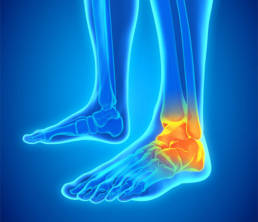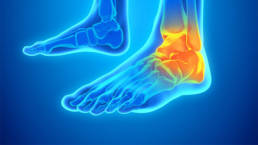FOOT AND ANKLE PAIN
Until you’ve experienced foot and ankle pain, you don’t know how much you are depending on the simple act of walking to accomplish routine tasks and maintain your quality of life. Fortunately, innovations in healthcare offered at PRI can bring lasting relief.
Non-Surgical Treatment of Foot/Ankle Pain

A product of cutting-edge medical innovation, s provide a revolutionary new therapy for treating foot and ankle pain. It offers the promise of restoring damaged tissue by promoting new growth. In the case of foot and ankle pain, this means the individual’s foot and ankle stop hurting because the cause of the pain has been repaired.
One of the most promising avenues of innovative medicine, and one we have explored extensively here at the Pain Relief Institute, all cutting edge forms of non-surgical treatment.
Other Non-Surgical Alternatives for Foot/Ankle:
Foot and Ankle Pain and Laser Therapy: Pain Relief Institute offers laser therapy for ankle sprains and foot and ankle pain. Laser therapy increases blood flow by vasodilating local blood vessels in an area with low blood flow compared to areas of the body that are surrounded by major muscle groups. This increased blood flow brings in the nutrients necessary to repair damaged tissues and removes the damaged tissue fibers. Laser therapy also increases lymphatic flow which helps to reduce local swelling, decreases prostagladin formation which reduces pain levels, increases endorphin production, and expedites the body’s natural healing processes, which allows for quicker introduction into rehabilitation.
Foot and Ankle Pain: Amnio-Derived Cellular Therapy is an advanced regenerative medicine treatment. Made up of amniotic fluid components, they provide an abundance of cytokines, nutrients, and growth factors and anti-microbial, anti-inflammatory, and regenerative properties. Platelet-Rich Plasma treatment may also be done in conjunction with Cellular Therapy to further enhance outcomes.
A sprain is a common cause of ankle pain. Pain can also be a result of: arthritis (specifically osteoarthritis); gout; nerve damage or injury, such as sciatica; blocked blood vessels; infection in the joint. A sprain is generally caused when the ankle rolls or twists so that the outer ankle moves toward the ground, tearing the ligaments of the ankle that hold the bones together. Rolling the ankle can also cause damage to the cartilage or tendons of your ankle.
Gout occurs when uric acid builds up in the body. This higher than normal concentration of uric acid (a byproduct of the body’s normal breakdown of old cells) can deposit crystals in the joints, causing sharp pain. Pseudogout is a similar condition where calcium deposits build up in the joints. Symptoms of both gout and pseudogout include pain, swelling, and redness.
Arthritis can also cause ankle pain. Arthritis is an inflammation of the joints. Multiple types of arthritis can cause pain in the ankles, but osteoarthritis is the most common.
Osteoarthritis is often caused by wear and tear on the joints. The older people are, the more likely they are to develop osteoarthritis.
Foot and ankle pain are often due to an ankle sprain but can also be caused by ankle instability, arthritis, gout, tendonitis, fracture, nerve compression (tarsal tunnel syndrome), infection, and poor structural alignment of the leg or foot. Ankle pain can be associated with swelling, stiffness, redness, and warmth in the involved area. The pain is often described as an intense dull ache that occurs in the foot bearing weight and with normal ankle motion.
Diagnosing the Cause of your Foot and Ankle Pain

